The External Pacemakers Market is estimated to be valued at USD 1.9 billion in 2025 and is projected to reach USD 2.6 billion by 2035, registering a compound annual growth rate (CAGR) of 3.4% over the forecast period.
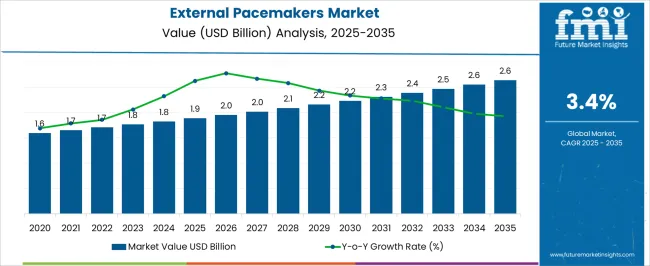
| Metric | Value |
|---|---|
| External Pacemakers Market Estimated Value in (2025 E) | USD 1.9 billion |
| External Pacemakers Market Forecast Value in (2035 F) | USD 2.6 billion |
| Forecast CAGR (2025 to 2035) | 3.4% |
The External Pacemakers market is experiencing steady growth driven by the increasing prevalence of cardiac arrhythmias, aging populations, and the rising need for acute cardiac care. The market is being shaped by the adoption of advanced pacing technologies that offer rapid deployment, safety, and reliability in emergency and clinical settings. Hospitals and cardiac care centers are increasingly investing in external pacemaker systems due to their life-saving potential and the ability to bridge patients to permanent implantable devices.
Technological advancements in device miniaturization, battery longevity, and wireless monitoring are further supporting market expansion. In addition, the growing awareness among healthcare professionals regarding early intervention for bradyarrhythmias and other cardiac disorders has reinforced demand.
As healthcare infrastructure continues to improve globally and emergency cardiac care becomes a priority, the market is expected to maintain a strong growth trajectory Future opportunities lie in integrating external pacemakers with telemetry and remote monitoring systems to provide comprehensive patient management and reduce hospital readmissions.
The external pacemakers market is segmented by pacing type, modality, end users, and geographic regions. By pacing type, external pacemakers market is divided into Transvenous pacing, Esophageal pacing, Transcutaneous pacing, and Epicardial pacing. In terms of modality, external pacemakers market is classified into Single chamber and Dual chamber. Based on end users, external pacemakers market is segmented into Hospitals and Clinics. Regionally, the external pacemakers industry is classified into North America, Latin America, Western Europe, Eastern Europe, Balkan & Baltic Countries, Russia & Belarus, Central Asia, East Asia, South Asia & Pacific, and the Middle East & Africa.
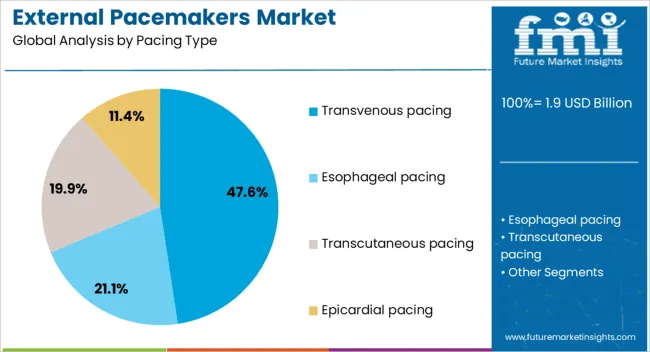
The transvenous pacing segment is projected to hold 47.60% of the External Pacemakers market revenue share in 2025, making it the leading pacing type. This dominance is being attributed to its reliability in delivering precise electrical stimulation directly to cardiac tissue and its established track record in critical care scenarios.
Adoption has been reinforced by the widespread use of transvenous leads in acute and temporary pacing, which ensures effective management of severe bradycardia and conduction disturbances. The flexibility of placement and compatibility with hospital monitoring systems have made this segment a preferred choice for cardiologists.
Additionally, the safety and efficiency associated with transvenous pacing, combined with minimal procedural complexity compared to other pacing modalities, have facilitated its broad utilization As hospitals continue to prioritize rapid response solutions for high-risk cardiac patients, the transvenous pacing segment is expected to maintain its leading position, supported by continuous improvements in lead design, electrode stability, and device programmability.
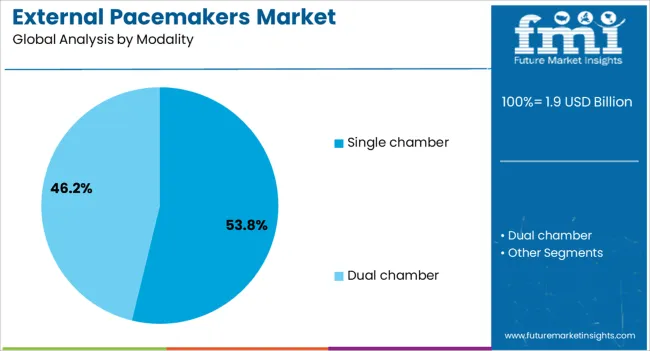
The single chamber modality segment is estimated to account for 53.80% of the market revenue in 2025, reflecting its prominence among pacing modalities. This segment has grown due to its clinical effectiveness in treating patients with isolated atrial or ventricular rhythm disturbances. Single chamber external pacemakers are valued for their simplified operation, ease of programming, and reduced procedural risk compared to dual chamber systems.
Their adoption is also supported by the ability to provide rapid, temporary pacing in emergency situations without the complexity of coordinating multiple leads. Hospitals and intensive care units have favored this modality because it enables immediate intervention while allowing monitoring for hemodynamic stability.
The consistent reliability, lower cost, and patient safety associated with single chamber systems have driven its widespread use Going forward, this segment is expected to continue leading the market as healthcare facilities increasingly rely on efficient and dependable pacing solutions for temporary cardiac support.
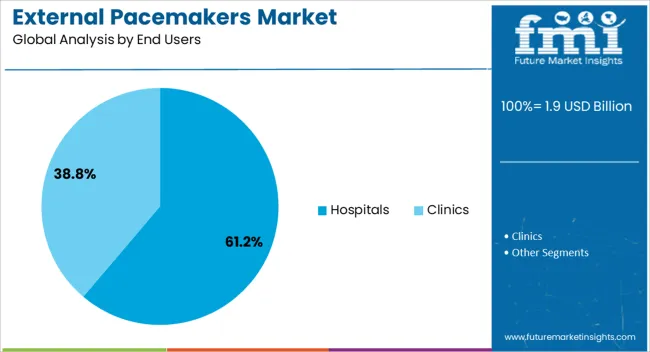
The hospitals end-user segment is projected to hold 61.20% of the External Pacemakers market revenue share in 2025, establishing it as the largest consumer segment. This leadership is driven by the high concentration of cardiac care procedures, emergency departments, and intensive care units that require immediate access to external pacing devices. Hospitals benefit from the ability to deploy these devices quickly for acute arrhythmias and postoperative monitoring, improving patient outcomes and reducing mortality rates.
Adoption has been reinforced by integration with hospital monitoring systems, ease of staff training, and compliance with regulatory safety standards. Additionally, the growing prevalence of cardiovascular diseases and increasing hospital admissions for cardiac emergencies have expanded the demand for temporary pacing solutions.
Hospitals are increasingly prioritizing the acquisition of advanced external pacemakers with programmable features, extended battery life, and compatibility with telemetric monitoring systems As cardiac care infrastructure continues to evolve globally, the hospital segment is expected to sustain its market dominance, driven by the need for efficient, life-saving interventions.
An external pacemaker is an artificial device intended to regulate the electrical conduction system of the heart by generating an electrical impulses delivered by electrodes placed on the patient's chest. The regulation of the electrical conduction system of the heart results in maintaining an adequate heart rate in cases, where the heart's natural pacemaker is irregular, or there is a block in the heart's electrical conductive system due to cardiopathies.
The primary indication of transcutaneous pacing is irregular beating of the heart (bradycardia). The external pacemakers are indicated for short-term demand pacing for therapeutic, prophylactic, or diagnostic purposes. External pacing should not be used for extended periods and serves as an emergency procedure until permanent implantable pacers are employed or the condition is mitigated using drug treatment.
The growing demand generated due to increasing incidence of bradycardias owing to cardiopathies such as myocardial infarction, sinus node dysfunction and complete heart block are the prime clinical drivers of the external pacemakers market.
According to the center for disease control and prevention, about 610,000 USA citizens die of heart disease each year with more than half of the deaths due to heart disease are in men. Coronary heart disease (CHD) is the major heart disease, resulting in over 370,000 deaths each year. The statistics also point to the fact that about 735,000 Americans suffer a heart attack each year. Speaking in economic terms, heart disease costs about obesity $200 billion each year to the USA exchequer, which includes the cost of health care services, medications, and lost productivity. Thus a large external pacemakers market is well evident even to an untrained eye.
The demographic drivers of the external pacemakers market include growing geriatric population, sedentary lifestyles, obesity, substance abuse, fatty food and others. The growing incidence of diseases such as diabetes, and hypertension indirectly aid the market growth as they result in greater risk of developing cardiopathies. According to the center for disease control and prevention, approximately 75 million Americans representing 32% of the population suffer from hypertension.
Technological advancements resulting in product development such as the development of demand external pacemaker, which activates only when it senses inadequate heart rhythms and thereby avoids competition with the hearts own natural pacemaker is driving a faster external pacemakers market adoption. Technological gains represent a significant market opportunity as they are expected to generate high impact on patient care.
Technologies such as remote wireless remote monitoring systems, advanced data analysis and recording resulting in plethora of information on patient health and device status is expected to result in growing functionality and market adoption. miniaturization is another trend, which is expected to boost the external pacemakers market growth.
However, the high cost of external pacemakers, competition from drug therapy, scarcity of trained manpower, the lower per capita income of the developing world is hampering the external pacemakers market.
The global market for external pacemakers is expected to charge owing to lowering of stringency of regulations. The USA The FDA has issued a proposal to lower the risk classification for external pacemaker pulse generators from Class III to Class II. However validation of effectiveness remains a prime criteria for market approval.
The global external pacemakers market can be classified into the following region: North America, Latin America, Western Europe, Eastern Europe, Asia-Pacific, Japan, Middle East and Africa. North America, led by the USA, is expected to account for the largest share in the global external pacemakers market, owing to the large demand, large healthcare expenditure, and large per capita income in the region.
The Asia Pacific external pacemakers market excluding Japan is projected to expand and dominate the scene in the near future, owing to the growing healthcare and large specialty hospitals.
China and India are anticipated to account for the major share of the Asia Pacific external pacemakers market growth. Germany, France and the UK, are projected to be the largest drivers of the Europe external pacemakers market. The Middle East and Africa External pacemakers market is anticipated to be dominated by the gulf economies of Saudi Arabia, Kuwait, UAE and Qatar.
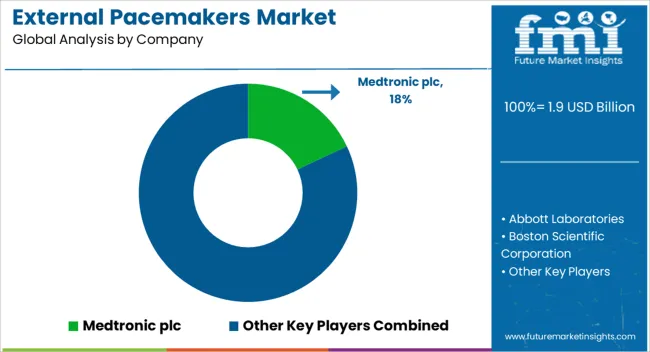
Some of the major vendors operating in the global external pacemakers market are Medtronic, OSCOR Inc, OSYPKA AG, Boston Scientific Corporation, Fluke, Shree Pacetronix Ltd., Abbott, Avery Biomedical Devices, Inc., St. Jude Medical, and others.
The global external pacemakers report is a compilation of first-hand information, qualitative and quantitative assessment by industry analysts, inputs from industry experts and industry participants across the value chain. The report provides in-depth analysis of parent market trends, macro-economic indicators and governing factors along with market attractiveness as per segments. The report also maps the qualitative impact of various market factors on market segments and geographies.
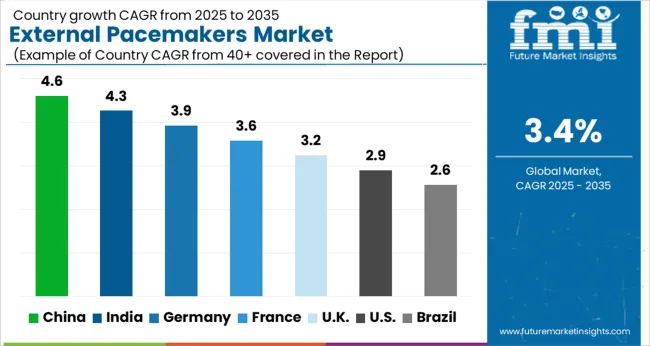
| Country | CAGR |
|---|---|
| China | 4.6% |
| India | 4.3% |
| Germany | 3.9% |
| France | 3.6% |
| UK | 3.2% |
| USA | 2.9% |
| Brazil | 2.6% |
The External Pacemakers Market is expected to register a CAGR of 3.4% during the forecast period, exhibiting varied country level momentum. China leads with the highest CAGR of 4.6%, followed by India at 4.3%. Developed markets such as Germany, France, and the UK continue to expand steadily, while the USA is likely to grow at consistent rates. Brazil posts the lowest CAGR at 2.6%, yet still underscores a broadly positive trajectory for the global External Pacemakers Market. In 2024, Germany held a dominant revenue in the Western Europe market and is expected to grow with a CAGR of 3.9%. The USA External Pacemakers Market is estimated to be valued at USD 653.9 million in 2025 and is anticipated to reach a valuation of USD 870.2 million by 2035. Sales are projected to rise at a CAGR of 2.9% over the forecast period between 2025 and 2035. While Japan and South Korea markets are estimated to be valued at USD 88.0 million and USD 62.4 million respectively in 2025.
| Item | Value |
|---|---|
| Quantitative Units | USD 1.9 Billion |
| Pacing Type | Transvenous pacing, Esophageal pacing, Transcutaneous pacing, and Epicardial pacing |
| Modality | Single chamber and Dual chamber |
| End Users | Hospitals and Clinics |
| Regions Covered | North America, Europe, Asia-Pacific, Latin America, Middle East & Africa |
| Country Covered | United States, Canada, Germany, France, United Kingdom, China, Japan, India, Brazil, South Africa |
| Key Companies Profiled | Medtronic plc, Abbott Laboratories, Boston Scientific Corporation, Biotronik SE & Co. KG, MicroPort Scientific Corporation, Cook Medical, Lepu Medical Technology (Beijing) Co., Ltd., and Osypka Medical GmbH |
The global external pacemakers market is estimated to be valued at USD 1.9 billion in 2025.
The market size for the external pacemakers market is projected to reach USD 2.6 billion by 2035.
The external pacemakers market is expected to grow at a 3.4% CAGR between 2025 and 2035.
The key product types in external pacemakers market are transvenous pacing, esophageal pacing, transcutaneous pacing and epicardial pacing.
In terms of modality, single chamber segment to command 53.8% share in the external pacemakers market in 2025.






Our Research Products

The "Full Research Suite" delivers actionable market intel, deep dives on markets or technologies, so clients act faster, cut risk, and unlock growth.

The Leaderboard benchmarks and ranks top vendors, classifying them as Established Leaders, Leading Challengers, or Disruptors & Challengers.

Locates where complements amplify value and substitutes erode it, forecasting net impact by horizon

We deliver granular, decision-grade intel: market sizing, 5-year forecasts, pricing, adoption, usage, revenue, and operational KPIs—plus competitor tracking, regulation, and value chains—across 60 countries broadly.

Spot the shifts before they hit your P&L. We track inflection points, adoption curves, pricing moves, and ecosystem plays to show where demand is heading, why it is changing, and what to do next across high-growth markets and disruptive tech

Real-time reads of user behavior. We track shifting priorities, perceptions of today’s and next-gen services, and provider experience, then pace how fast tech moves from trial to adoption, blending buyer, consumer, and channel inputs with social signals (#WhySwitch, #UX).

Partner with our analyst team to build a custom report designed around your business priorities. From analysing market trends to assessing competitors or crafting bespoke datasets, we tailor insights to your needs.
Supplier Intelligence
Discovery & Profiling
Capacity & Footprint
Performance & Risk
Compliance & Governance
Commercial Readiness
Who Supplies Whom
Scorecards & Shortlists
Playbooks & Docs
Category Intelligence
Definition & Scope
Demand & Use Cases
Cost Drivers
Market Structure
Supply Chain Map
Trade & Policy
Operating Norms
Deliverables
Buyer Intelligence
Account Basics
Spend & Scope
Procurement Model
Vendor Requirements
Terms & Policies
Entry Strategy
Pain Points & Triggers
Outputs
Pricing Analysis
Benchmarks
Trends
Should-Cost
Indexation
Landed Cost
Commercial Terms
Deliverables
Brand Analysis
Positioning & Value Prop
Share & Presence
Customer Evidence
Go-to-Market
Digital & Reputation
Compliance & Trust
KPIs & Gaps
Outputs
Full Research Suite comprises of:
Market outlook & trends analysis
Interviews & case studies
Strategic recommendations
Vendor profiles & capabilities analysis
5-year forecasts
8 regions and 60+ country-level data splits
Market segment data splits
12 months of continuous data updates
DELIVERED AS:
PDF EXCEL ONLINE
External Anthelmintic for Dogs Market Size and Share Forecast Outlook 2025 to 2035
External Storage Market Size and Share Forecast Outlook 2025 to 2035
External Fixator Market Size and Share Forecast Outlook 2025 to 2035
External Anti-infective Preparations Market Size and Share Forecast Outlook 2025 to 2035
External Blinds Market Size and Share Forecast Outlook 2025 to 2035
External Defibrillators Market Size and Share Forecast Outlook 2025 to 2035
External Gear Pump Market Size, Growth, and Forecast 2025 to 2035
External Combustion Engine Market Growth & Demand 2025 to 2035
Animal External Fixation Market Size and Share Forecast Outlook 2025 to 2035
Automated External Defibrillator Market Analysis – Size, Share, and Forecast 2025 to 2035

Thank you!
You will receive an email from our Business Development Manager. Please be sure to check your SPAM/JUNK folder too.
Chat With
MaRIA